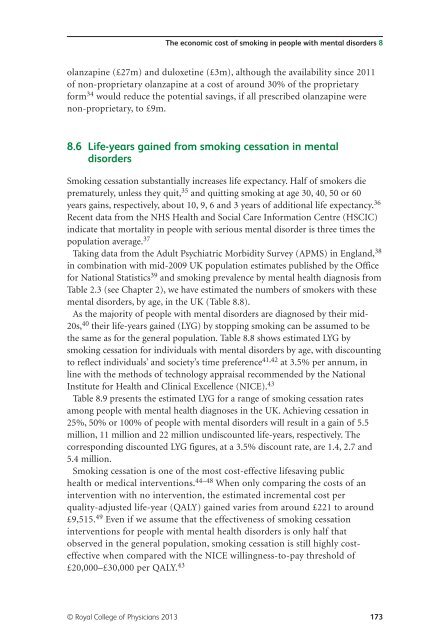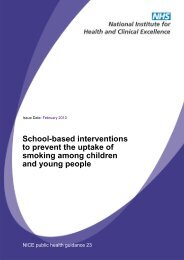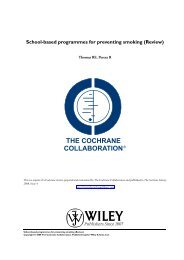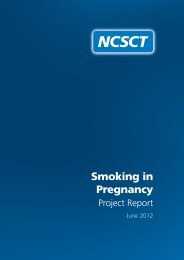Smoking and mental health - NCSCT
Smoking and mental health - NCSCT
Smoking and mental health - NCSCT
You also want an ePaper? Increase the reach of your titles
YUMPU automatically turns print PDFs into web optimized ePapers that Google loves.
The economic cost of smoking in people with <strong>mental</strong> disorders 8<br />
olanzapine (£27m) <strong>and</strong> duloxetine (£3m), although the availability since 2011<br />
of non-proprietary olanzapine at a cost of around 30% of the proprietary<br />
form 34 would reduce the potential savings, if all prescribed olanzapine were<br />
non-proprietary, to £9m.<br />
8.6 Life-years gained from smoking cessation in <strong>mental</strong><br />
disorders<br />
<strong>Smoking</strong> cessation substantially increases life expectancy. Half of smokers die<br />
prematurely, unless they quit, 35 <strong>and</strong> quitting smoking at age 30, 40, 50 or 60<br />
years gains, respectively, about 10, 9, 6 <strong>and</strong> 3 years of additional life expectancy. 36<br />
Recent data from the NHS Health <strong>and</strong> Social Care Information Centre (HSCIC)<br />
indicate that mortality in people with serious <strong>mental</strong> disorder is three times the<br />
population average. 37<br />
Taking data from the Adult Psychiatric Morbidity Survey (APMS) in Engl<strong>and</strong>, 38<br />
in combination with mid-2009 UK population estimates published by the Office<br />
for National Statistics 39 <strong>and</strong> smoking prevalence by <strong>mental</strong> <strong>health</strong> diagnosis from<br />
Table 2.3 (see Chapter 2), we have estimated the numbers of smokers with these<br />
<strong>mental</strong> disorders, by age, in the UK (Table 8.8).<br />
As the majority of people with <strong>mental</strong> disorders are diagnosed by their mid-<br />
20s, 40 their life-years gained (LYG) by stopping smoking can be assumed to be<br />
the same as for the general population. Table 8.8 shows estimated LYG by<br />
smoking cessation for individuals with <strong>mental</strong> disorders by age, with discounting<br />
to reflect individuals’ <strong>and</strong> society’s time preference 41,42 at 3.5% per annum, in<br />
line with the methods of technology appraisal recommended by the National<br />
Institute for Health <strong>and</strong> Clinical Excellence (NICE). 43<br />
Table 8.9 presents the estimated LYG for a range of smoking cessation rates<br />
among people with <strong>mental</strong> <strong>health</strong> diagnoses in the UK. Achieving cessation in<br />
25%, 50% or 100% of people with <strong>mental</strong> disorders will result in a gain of 5.5<br />
million, 11 million <strong>and</strong> 22 million undiscounted life-years, respectively. The<br />
corresponding discounted LYG figures, at a 3.5% discount rate, are 1.4, 2.7 <strong>and</strong><br />
5.4 million.<br />
<strong>Smoking</strong> cessation is one of the most cost-effective lifesaving public<br />
<strong>health</strong> or medical interventions. 44–48 When only comparing the costs of an<br />
intervention with no intervention, the estimated incre<strong>mental</strong> cost per<br />
quality-adjusted life-year (QALY) gained varies from around £221 to around<br />
£9,515. 49 Even if we assume that the effectiveness of smoking cessation<br />
interventions for people with <strong>mental</strong> <strong>health</strong> disorders is only half that<br />
observed in the general population, smoking cessation is still highly costeffective<br />
when compared with the NICE willingness-to-pay threshold of<br />
£20,000–£30,000 per QALY. 43<br />
© Royal College of Physicians 2013 173














